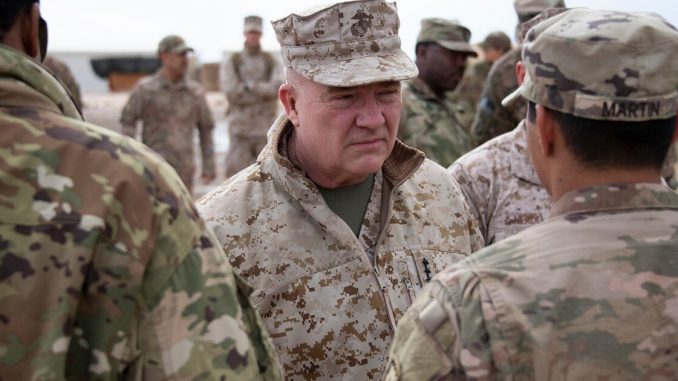
A recent, steady flow of rocket attacks in the past week on facilities housing U.S. troops in Iraq, including Camp Taji and Baghdad, may be attempts of Iranian-backed groups to pressure an American exit. But the region’s top military commander sees little effect.
“We’re not going to quit the region in response to Iranian pressure,” Gen. Kenneth McKenzie said on an Atlantic Council online interview with Washington Post columnist David Ignatius.
These attacks come just days after a joint announcement by the Iraqi and U.S. governments on a plan to reduce troop numbers in the country in the coming months. That announcement came June 11 in a Department of State release and further negotiated details are expected in a meeting scheduled in July, an official said.
McKenzie recounted tit-for-tat attacks and provocations by Iran and the U.S. military and coalition responses, asserting that those responses were actually de-escalations of Iranian probing.
“While Iran may own the escalatory ladder,” the Marine general said Thursday. “Iran needs to understand that the United States controls the final steps in an escalatory ladder.”
/arc-anglerfish-arc2-prod-mco.s3.amazonaws.com/public/BAD33Y5MQNAYPDEDAD66KZ4YWU.jpg)
The four-star acknowledged that since the March rocket attacks at Camp Taji, Iraq, which wounded five, three of which were American, there had been a “pause” in Iranian attacks.
He attributed some of that to changes in U.S. force posture, protests by Iraqis against Iranian groups trying to influence their elections and the coronavirus pandemic.
But, with this past week he also said they were seeing a “spike” in attacks that has restarted.
A spokesman for Combined Joint Task Force-Operation Inherent Resolve, Army Col. Myles Caggins told Military Times Thursday, providing context to the recent attacks and the status of U.S. forces in Iraq.
At present, there are about 5,200 U.S. troops in the country. Those troops are not conducting dismounted patrols, and do not bring heavy armor or other such assets. They are relying on Iraqi forces for protection but retain the ability and right to defend themselves if needed, he said.
That is crucial, Caggins said, because the mission of the troops there is to defeat ISIS and the rocket attacks and other such incidents draws attention from that mission.
The Iraqis, Caggins said, understand that and have been pursuing the source of attacks when detected and, in some cases, arresting perpetrators when found. At each attack they trace the launch and collect evidence for potential future criminal cases.
“These attacks are definitely a threat, we take them very seriously,” Caggins said.
/cloudfront-us-east-1.images.arcpublishing.com/mco/BAD33Y5MQNAYPDEDAD66KZ4YWU.jpg)
A former senior military officer with U.S. Central Command told Military Times that the lack of response to the Jan. 8 rocket attack on al-Asad airbase that caused more than 100 U.S. troops Traumatic Brain Injury emboldened Iranians in their continued attacks.
The attack was a reaction to a U.S. airstrike, days earlier, that killed Qasem Soleimani, the head of the Iranian Revolutionary Guard Corps-Quds Force.
“That leads the Iranians to think, ‘okay the redline isn’t that so where is the redline?,” he said. “We’re inconsistent. They’ll continue to push to see how far they can go until someone does something really hurtful to them.”
For a more nuanced picture, Caggins said that the most severe attack, in December at Kirkuk, had more than 30 rockets fired on the position, according to estimates. The March Camp Taji attack involved as many as 20 rockets.
Data provided by CJTF-OIR staff showed 21 indirect fire attacks on coalition bases for 2019, which included an estimated 107 rockets.
So far, in 2020, there have been 26 such attacks as of Thursday. Seven of those in June.
The most recent attacks have been in single digits, sometimes only one rocket, some have fallen as far as 1.5km from their target.
Primarily, what are believed to be proxy military forces backed by Iran are using 107mm katyusha rockets. The Russian-made “Little Katy” rocket ranges are unguided and have been in use by the jihadi group Hezbollah for years. Smaller variants reach ranges of about 4km and can carry a 10-20kg warhead with high explosives, according to data compiled by the Center for Strategic and International Studies.
Since the start of the year, U.S. troop numbers have decreased from nearly 6,000 to the current level of about 5,200. Those 800 troops are not scheduled to return.
Also, 1,200 coalition forces have left Iraq due to training halts because of the coronavirus pandemic, he said.
Also, the areas of U.S. troop dispersion and force posture has shifted.
That personnel has moved out of six locations: Mosul, Kirkuk, Al-Qa’im, Abu Ghraib, Habbaniyah and Qayyarah Airfield West.
Troops remain in Irbil, al-Assad, Camp Taji and the Baghdad cluster, or the Green Zone.
The U.S. Embassy in the Green Zone and Green Zone have also been the targets of attack over the past week.
“We don’t want to maintain a large force there,” McKenzie said. “We’re adjusting the force structure, it’s been larger, it’s getting smaller.”
The number will lower over time, as was stated in a June 11 joint statement released by the U.S. Department of State by both the governments of Iraq and the United States.
“On the security partnership, the two countries recognized that in light of significant progress towards eliminating the ISIS threat, over the coming months the U.S. would continue reducing forces from Iraq and discuss with the Government of Iraq the status of remaining forces as both countries turn their focus towards developing a bilateral security relationship based on strong mutual interests,” according to the statement.
Whatever the force structure becomes, the general said, it will depend on conditions in Iraq and what the Iraqi government wants.
“And I do not believe that number will be zero,” he said.


Be the first to comment